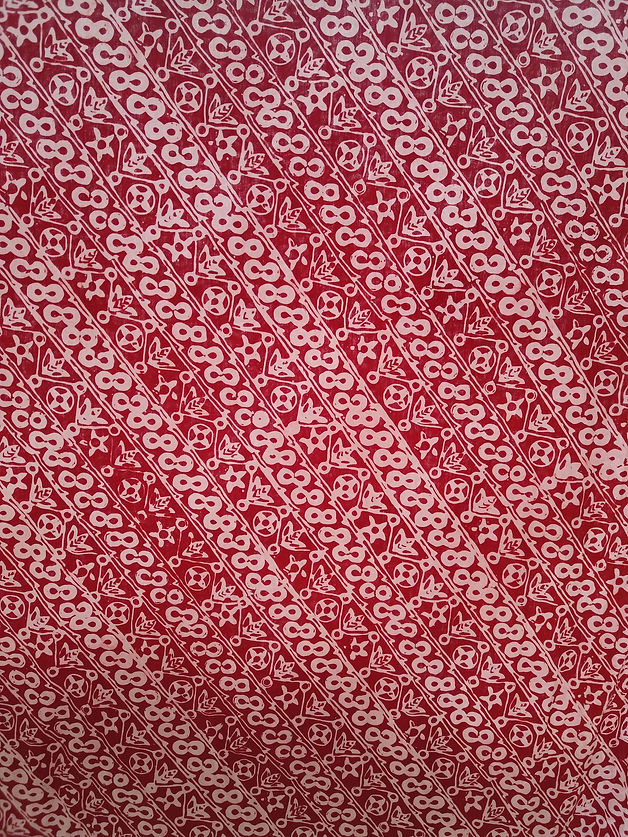
What is Batik Geblek Renteng?
Its History
Batik is considered as one of Indonesian heritage. This was also acknowledged by UNESO in 2009 as "Masterpiece of Oral and Intangible Heritage of Humanity”. Each region in Indonesia has owned and developed their batik motives which inclusively embody the identity of that particular region, for example batik Mega Mendung from Cirebon.
Kulon Progo, a district in Special Region of Yogyakarta has had actually its own batik motive but it can not be identified who were the first creator of it and also has not been recognised as the icon of Kulon Progo. The batik industry in Kulon Progo has been also growing rapidly. Thus, the local government initiated to hold a competition to find the best motives which later on be the icon of Kulon Progo.
The competition begun at February 1st, 2012 and was targeting several points:
-
Sustaining and developing batik culture
-
Encourage citizen creativity to design batik motives
-
Increasing public awareness of the batik culture
-
Creating a new batik variety that representing Kulon Progo
-
Promoting batik industry in Kulon Progo and improving the community economy
Per April 30th, 2012 the competition closed and already collected 392 creation of batik motives from 304 participants to enter the assessment stage. At May 6th, 2012 the winner was announced and batik motive “Geblek Renteng” was the champion.
Design Type of Batik Gebleg Kenteng
The batik Geblek Renteng consists of three elements: Geblek, Binangun symbol, and Mangosteen. These contains a deep philosophy value. Geblek placed next to each other represents the traditional food originally from Kulon Progo. Binangun symbol which is drawn as flower buds that is going to bloom represents that Kulon Progo is a developing region that would be developed soon. Next to it, we can see the mangosteens. Mangosteens are once again represents Kulon Progo typical fruit. These components are patterned ups and downs. This also represents Kulon Progo as a land which has mountains, lands, and beaches.


Materials
Materials used to make the batik is the best fabric. There are two materials: cotton and silk, with silk has higher price compared to cotton due to several aspects concerning fineness and comfort.

Main Process and Craftsmanship
Like any other batik, Geblek Renteng has also two method: hand-drawn and stamped. Hand-drawn batik is created manually one by one using canting whereas the stamped one using stamps which has batik pattern on it. The hand-drawn is simply more artistic and represents the batik culture in truly.
Steps in creating hand-drawn batik:
-
Nyorek
-
Nglowong
-
Isen-isen and Nembok
-
Medel, Negbyok
-
Mbironi and Nembok
-
Nyoga, and Nglorod
Guidance to Choose the Best Product
Those interested in buying written batik will want to look at the three aspects below to choose the best fabrics.
Color Scheme
The traditional way of making batik uses malam (hot liquid wax), which was introduced by the Gujarati traders who came to Java in the 6th century.
Both the handmade batik tulis and batik cap are created using natural dyes made from leaves and flowers, which produces a range of earth tones and generally feature the deep-brown sogan color that resembles the color of soil. These batik are sometimes also called batik sogan.
Meanwhile, printed batik uses chemical dyes that result in brighter, more vibrant colors and a wider range of color variations.

Reverse Side
One easy way to identify handmade written batik is by checking the "reverse" side of the fabric. In printed batik, the reverse side is visibly evident with faded colors, as only one side of the fabric is printed using a textile printer.
On the other hand, written batik is made by applying wax to both the front and back of the fabric, and the color is consistently bright on both sides, as the fabric is hand-dyed by submerging into a vat of dye.

Organic Appearance
Every stroke in a written batik is drawn by hand using a canting, a special copper-bowled implement, which results in a more "organic" appearance to the fabric's motifs.
Moreover, since it’s hand-drawn, a written batik may sport some unique stains or other anomalies. Although this may make written batik look untidy when compared with printed batik, it is this beautiful mess that makes written batik more valuable.


